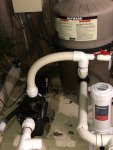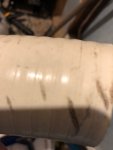So these questions started in this thread, trying to figure out the right spot to put my SWG. I've settled on putting in the return branch that goes to the pool returns. I'll post pic of my pad later to help visualize. My questions now remain:
1. As noted in the linked thread, I decided to put in a bypass setup for the heater. Was it really worth it for me to plumb in the heater bypass? I decide it was a good idea without much research but the linked discussion has got me wondering if there is really much benefit. My path is already set, as I've already glued those bypass valves in so I can't return them and it would be more work to take them out now. I'm posing the question for my education and future benefit as well as anyone who goes searching for this topic in the future, that others may learn from my experience. (If you think it was a un-needed approach you won't hurt my feelings)
2. When I was looking at @sgoosman 's post here it got me thinking about flexible PVC. That might help me be better able to fit things in. Anyone have any experience/thoughts/recommendation on incorporating it into an equipment setup? I didn't even think of it but I love PEX and flex pipe for tough spots with sprinklers, etc. Something like this?
Thanks for the input.
1. As noted in the linked thread, I decided to put in a bypass setup for the heater. Was it really worth it for me to plumb in the heater bypass? I decide it was a good idea without much research but the linked discussion has got me wondering if there is really much benefit. My path is already set, as I've already glued those bypass valves in so I can't return them and it would be more work to take them out now. I'm posing the question for my education and future benefit as well as anyone who goes searching for this topic in the future, that others may learn from my experience. (If you think it was a un-needed approach you won't hurt my feelings)
2. When I was looking at @sgoosman 's post here it got me thinking about flexible PVC. That might help me be better able to fit things in. Anyone have any experience/thoughts/recommendation on incorporating it into an equipment setup? I didn't even think of it but I love PEX and flex pipe for tough spots with sprinklers, etc. Something like this?
Thanks for the input.



